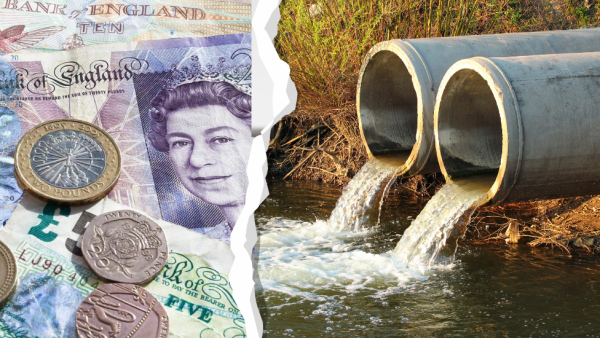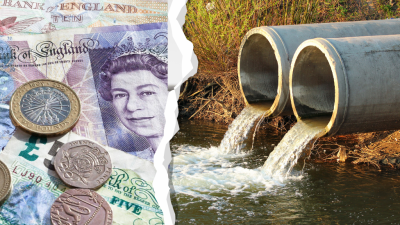
7 Apr 2025
Almost everyone acknowledges that water privatisation has failed. The main argument the government now uses against public ownership is the cost of buying back the water companies.
New research from the University of Greenwich has found that an average of 35% of customer bills in 2023-2024 was taken out to pay for the interest on the companies’ ever-growing debt piles, and to pay dividends to the shareholders.
You are paying a privatisation tax for the dividends and debt of these companies.
Over one-third of customer bills for water in England and Wales pass straight through the companies without being used for water and sewerage services.
Publicly owned Scottish Water doesn’t have to pay dividends to private shareholders, and lost just 8% of revenue in interest payments in 2023-24: less than a quarter of the cost in England and Wales.
This means that if water in England was in public ownership, it would be four times cheaper to invest in cleaning up sewage.
The government says we can’t afford public ownership of water. But something doesn’t add up here.
If privatisation is such a rip off, how can it be more expensive to carry on with the existing system?
The only question is how we get from here to there. The government says the *transition itself* from our privatised system to a system of public ownership would be too expensive.
The University of Greenwich has crunched the numbers on the different scenarios for taking water into public ownership.
Financial ratings company Moody’s has correctly stated: “the level of compensation would fall within the wide discretion of parliament”. The UK parliament can decide what is appropriate, taking into account the public interest.
There are different principles at stake in the discussion of compensation. Should the shareholders receive full “market” value because that is their expectation, even though the market is one whose terms are set by government? Should they receive back the money they’ve invested? Or should they receive nothing if they have failed to deliver what they promised? These three scenarios are outlined below.
The important point about this new research is that under any of these scenarios, public ownership provides a better deal for taxpayers and households.
Scenario 1: The government’s scenario
The government claims that bringing water into public ownership would cost £100 billion. This is based on a 2018 report by the Social Market Foundation which said that nationalising water would cost £90 billion. This report was funded by the water industry: United Utilities, Anglian Water, Severn Trent and South West Water.
There are problems with this report, it has been described as “economically illiterate” by Professor Dieter Helm, an expert in the sector who does not support public ownership but says that the cost of buying back water is not an issue.
Market value is based on the current rip off
The SMF estimate is based on market value, but the privatised water companies’ market value is high *precisely because* they are ripping off households and polluting for profit. Their expected future earnings from these assets are, by definition, unreasonably high! In other words, the more they rip us off, the less we can afford to buy them back. The problem is that the “market” for water is not a real market and has allowed the companies to extract value at our expense for 36 years.
A further issue is that compensating shareholders at full market value arguably undermines environmental regulation by rewarding poor performance. Arguably too, owners should insure themselves against risk, including the risk of expropriation, rather than be supported by public money.
Water is an asset - it is better to own than to rent
Water is a profitable industry. Every penny of investment since 1989 has come from our bills. This means that the water companies are an asset which produces a revenue stream. So if the government buys this asset, they will also receive the money from customer bills.
Although the SMF report itself recognises that “the government would acquire an asset which at present makes a profit” the politicians do not seem to recognise this fact.
The benefit of paying £90 billion
The SMF report added together three elements:
-
The market value of the privatised water companies (as we’ve established, this is based on a rip off! But we’ll ignore this for the sake of argument)
-
An acquisition cost, an additional payment on top which they say shareholders would request
-
The net debt of these companies
However, if the government did pay this level of compensation, they would also be paying off 100% of the companies’ debts. This would mean a huge saving on the interest from the current debt mountain, because public sector debt is so much cheaper than private.
The research out now shows that if the government did compensate shareholders at this extremely high level, it would still be a good deal.
Yes, it would add to the public debt - around 3% to the government’s existing debt of £2,686 billion. But it would be cheaper.
A conservative estimate suggests it would save around £3 billion a year. This extra money could go towards cleaning up sewage, or it could be returned to households in the form of cheaper bills - saving you at least £100 a year.
Nationalising water is best deal for households and public purse, *even if shareholders receive £90 billion*.
Scenario 2: Paying the shareholders what they’ve put in
The Financial Times reported in 2019 that nationalising water by compensating shareholders for the money they’ve actually invested could cost as little as £14.5 billion.
“Calculations for the Financial Times by Moody’s, the rating agency, estimated the book value of the 15 English water companies’ shareholder equity at £14.5bn.
This is much less than an industry-funded estimate by the Social Market Foundation, a think-tank, which suggested a cost of £44bn to compensate shareholders based on market value — rising to a total expense of £90bn if the companies’ debt was included.”
The research says that today, according to the company balance sheets, shareholders have invested £13.2 billion. It explains that most of this is retained earnings from profits (where profits are held onto for the future) so shareholders have only actually injected £4.8 billion.
The money invested by shareholders has reduced in real terms since privatisation in 1989, again according to the Financial Times.
Scenario 3: Special administration to defend households and the environment
If you believe the privatised water companies have failed, you may also think that the most sensible way to bring the privatised water companies into public ownership is to use existing legal powers of “special administration”.
The government has these powers because water provides an essential service and so water companies cannot just “go bust” in the way a normal company might, in a normal market.
Special administration powers can be used in two scenarios:
-
If the water company is financially insolvent, for example in the case of Thames Water which is drowning in £19 billion of debt and is now being allowed to be bailed out by its 16 million customers, who have no choice but to pay £250 per household for an additional debt of £3 billion. The alternative to this is special administration.
-
If the water company is not fulfilling its statutory obligations, for example to look after the environment by investing to stop sewage. Thames Water could also be brought into special administration on this basis.
If a water company is brought into special administration, this will involve a financial restructuring and it will then be transferred to a new owner. We believe this new owner could and should be a publicly owned and accountable regional water company.
Shareholders for the failed company would not be compensated in the case of special administration.
Bondholders who have lent money to the company would expect to get a “haircut” in this case - in other words, they won’t get all their money back.
The Treasury has estimated that 40% of the debt would be cut in the case of Thames Water, JP Morgan thought that as much as 55% of the debt might be cut. So the debt would be roughly halved, and then refinanced as public sector debt at a lower interest rate, meaning it would be much cheaper to pay back.
Back in 2001, when Railtrack failed in private hands - it caused deadly accidents on the railway and then went bust - it was brought into special administration.
New Labour defended the public interest by quietly transferring the company into public ownership. The government said they were “not prepared to fund the poor performance of individual companies”.
The law says that “legitimate objectives of public interest’, for example economic reform or social justice concerns, may mean that shareholders can be reimbursed less than “full market value”. In the case of Railtrack, shareholders still received £500 million, they were not happy but the company was going bust.
“One could be left wondering what it would possibly take for a licence to be removed. If multiple and deliberate breaches of environmental law and repeated deception of the regulator by the provision of falsified performance information is not enough, what fear can those in the sector really have? Ofwat must be much clearer on when owners lose the licence through special administration. Will the Minister commit to setting the bar for special administration in legislation?” Emma Hardy MP, before becoming a Minister in government and failing to bring any water companies into special administration.
Paying a privatisation tax forever more?
Right now in England and Wales we are all paying a privatisation tax. The water companies are assets which bring in revenue. That money from our bills could be flowing back into investment and lower bills, not out in dividends and debt payments.
This new research shows that public ownership would save households £100-£160 per year or allow £3 to £5 billion more investment a year in reducing sewage, depending on how much shareholders are compensated.
Currently, the government is choosing to force billpayers to pay extra forever more so that privatisation can continue. The only thing we have to show for this is that the national debt is 3% lower than it would be in the worst case scenario - but the reality is that the government could make it far cheaper than that to buy back the water companies, as described above.
The most expensive scenario for nationalisation is still better for households in England and Wales. It is cheaper to finance investment in cleaning up sewage under public ownership rather than private. This means that even if shareholders are compensated at so-called “market” value, public ownership is still the best deal for the future.
The government must stop repeating the myth that nationalising water costs too much. Clearly, privatisation costs too much, ongoingly, and even if we accept the terms of the current rip off when deciding on the level of compensation for shareholders, we would win overall by buying them out.
Privatisation has been ripping us off for 36 years and there is no end in sight until we understand this. Let’s take back control of the water companies so they can work for households and the environment, not a handful of shareholders across the world.


Comments
Gertraude Murray 8 months ago
I always said that water privatisation was unethical and amoral,as nobody can live without water.
Reply